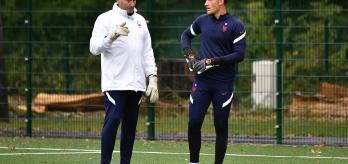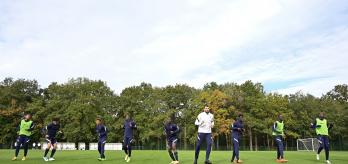The aim of this session is to tactically prepare France’s starting 11 for the first of two games against Wales and the problems that they could face against Wales’s 4-4-2 diamond. This session focuses on France’s press and is broken down into two parts, a passing circuit followed by an 11v10 game scenario. Twenty outfield players and a goalkeeper take part in the session.
Session overview
Key coaching points
-
The three midfielders should adjust their positioning to mark Wales’s holding midfielder and disrupt his ability to link up with the centrebacks.
-
The full‑back on the ball side of the pitch should be ready to step out and close down the unmarked midfielder, while the other full-back tucks in to provide cover and form a 3v2 against the two Wales forwards.
-
The wide players (wingers and full‑backs) must adjust their positioning when they are on the non‑ball side of the pitch so that they are close enough to apply pressure on the opposition’s centre-back and full‑back, to block Wales’s options to switch the play and to prevent the team unit from having to chase the ball from one side of the pitch to the other.
-
The wingers and full-backs must communicate with each other in order to track the player(s) who are left free and to close the spaces infield.
-
When the team are unable to close down the player in possession and he has time and space, the defensive line should anticipate a long, deep ball by adopting a three‑quarter position and retreating slightly to give themselves a head start on the opposition forwards.
Exercise 1 – passing circuit
This first exercise aims to improve players’ passes and first‑time balls. Players repeat the circuit twice and are then free to use different combinations.
-
Set up three exercise zones, each comprising 6 or 7 players.
-
Each exercise zone is 26x10m.
-
Two players are positioned in the middle of each exercise zone.
-
The other players are positioned along the edge of the exercise zone across the width of the pitch.
-
A dummy is also positioned in the middle of each exercise zone.
-
Players change positions when called by the coach.
-
A player positioned along the edge of the playing area plays a firm pass to a team‑mate positioned in the middle of the area.
-
The player receiving the pass plays a first‑time ball to the team‑mate positioned alongside the player who played the initial pass.
-
This player then finds the player across from him, on the opposite side of the playing area.
-
The circuit continues on the other side; this time, the second player positioned in the middle of the playing area plays the first‑time pass.
-
Instead of playing a first‑time pass to the second player on the edge of the playing area, the player who receives the ball in the middle plays a one‑touch lay‑off to the team‑mate alongside him, who then plays the ball to the other side of the playing area.
-
Finally, players are free to alternate between the two circuits and can also play aerial passes to shift the ball from one side of the playing area to the other.
-
Play firm passes along the ground and high-quality, first‑time balls to circulate the play quickly.
-
Combine with the players in the middle to progress the play by using lay‑offs.
-
The two players in the middle should coordinate their movements so that the player laying the ball off is able to play it into the path of the second player, facing the play, enabling him to play a first‑time ball to the player on the edge of the playing area.
Exercise 2 – defensive set-up against a 4-4-2 diamond – 11v10
The aim of this exercise is to prepare the defensive set-up of France’s 10 outfield players who will start against Wales. As explained during the video presentation prior to the training session, France will set up in a 4-3-3 formation against a Wales side that have deployed a 4-4-2 diamond in their most recent outings. This exercise therefore creates a game scenario for the 10 outfield players to work on defensive movements to counter Wales playing out from the back.
-
Set up a playing area of around 65m long and across the full width of the pitch.
-
A channel is marked out by cones on each wing.
-
The two number 8s in the diamond cannot enter these channels.
-
The team with 11 players attempt to build from the goalkeeper and progress the ball into the stop-ball zone, which is marked out beyond the halfway line.
-
The team with 10 players attempt to win the ball and finish on goal.
-
The team with 11 players must play the ball on the ground.
-
When the ball goes out of play, the game restarts from the goalkeeper.
-
Allow the team with 11 players to play aerial passes.
-
When Wales play the ball out to their right‑hand side and the ball is in the build‑up phase, France’s left‑midfielder comes out to mark Wales’s holding midfielder. France’s right‑midfielder marks Wales’s left‑midfielder, while France’s central midfielder marks Wales’s number 10, leaving Wales’s right‑midfielder free.
-
France’s left-back comes inside to mark the free midfielder. France’s right‑back tucks inside to join the two central defenders and provide 3v2 cover against the two Wales centre‑forwards.
-
When Wales are in a position to switch the play, France’s right‑back must anticipate the switch and step out towards Wales’s left‑back in order to hinder the switch or be close enough to press the player. This allows the France defender to close Wales’s left-back down on his first touch, should he receive the ball. France’s left‑back should, in turn, shift across to provide defensive cover.
-
France’s wingers have to constantly adjust their positioning so they are close enough to apply pressure on both the full‑back and the centre-back. The winger presses the centre‑back only if he receives the ball from the opposite flank.
-
If Wales manage to find their right‑back in behind France’s left winger, the left‑back must be ready step out and close him down quickly. The three midfielders should then shift across to mark the three Wales midfielders on the ball side and prevent them from moving the ball infield. France’s far‑side winger should then track back to within pressing distance of Wales’s free midfielder, but also position himself close enough to the centre‑back furthest from the ball in order to be able to close him down if Wales try to switch the play.












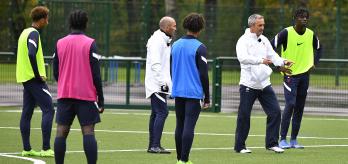
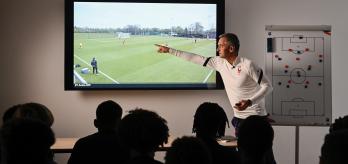
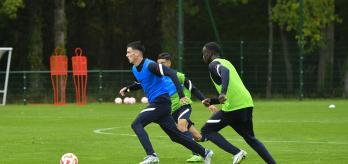
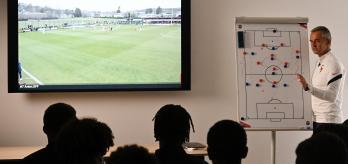
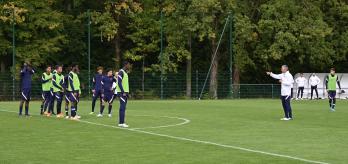
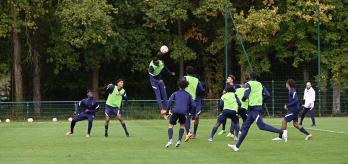

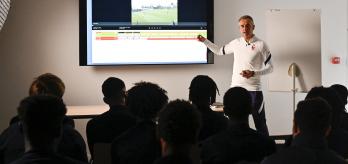

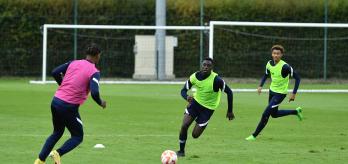

.variant64x64.jpeg)




.variant348x164.jpeg)
